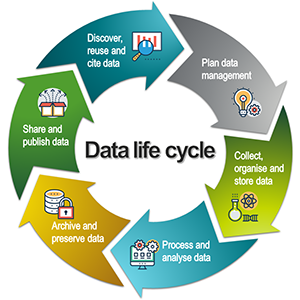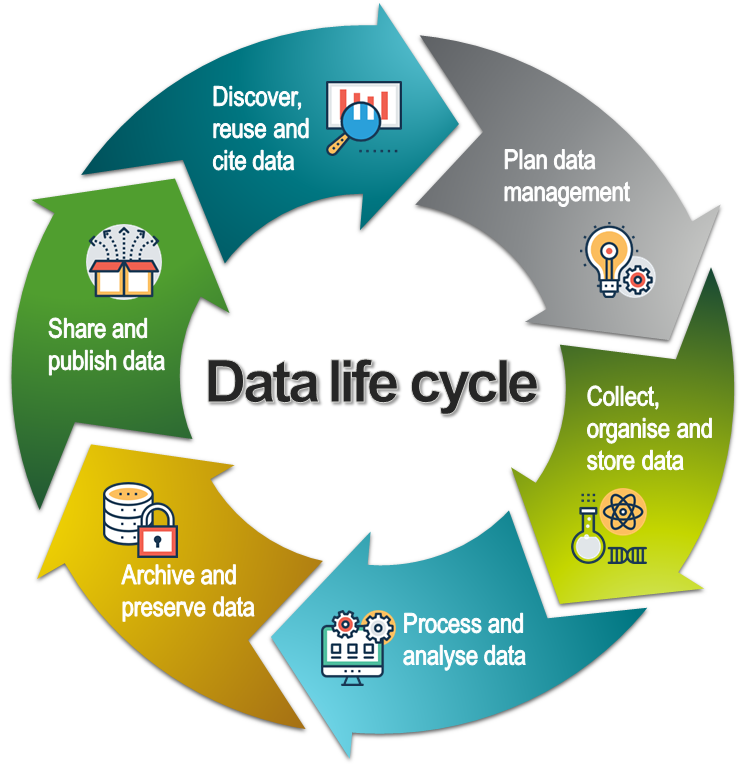Contact
Data Management Support (DMS)
dms@slu.se | www.slu.se/dms

Data management is about how scientific data is managed, organised and structured in research projects and environmental monitoring and assessment activities.
Data management is an integral part of all aspects of the the so-called data life cycle – planning, collecting, processing, analysing, preserving, sharing and re-using. It includes organisation, documentation, storage, publication, and archiving.
SLU has a data management policy that aims to promote the transition to open science and to increase the quality, dissemination, impact and innovation of research. The policy states that the research and environmental monitoring and assessment conducted at SLU should be characterised by good data management throughout the entire life cycle.
Research data is any information generated or compiled as part of a research activity. Research data can consist of facts, measurements, recordings, records or observations about the world collected by researchers and others, with a minimum of contextual interpretation.
In the context of this introduction, data from SLU’s environmental monitoring and assessment can be considered in the same way as research data.
SLU's data management policy applies to all types of digital data produced and/or processed within research and environmental monitoring and assessment at SLU.
The purpose of good data management is to improve the value of the data and the research and facilitate more efficient use of resources. Or, in the words of Wilkinson et al (2016):
Good data management is not a goal in itself, but rather is the key conduit leading to knowledge discovery and innovation, and to subsequent data and knowledge integration and reuse by the community after the data publication process.
Good research data management is also beneficial for the researcher and the research project. Some examples of the benefits of good research management are listed below.
Good research data management will enable you to organise files and data for easy access and analysis, both on an individual as well as project level. By organising files and data in a structured way future data retrieval will be optimised and risk of data loss minimised.
Accurate and complete research data is crucial for validating, evaluating, and reproducing research output.
Making data available boosts the visibility of your findings and ideally also increases the specific number of citations. Research data – if correctly formatted, described, and annotated – will have significant ongoing value and can continue to have impact long after the completion of a research project.
By facilitating sharing and reuse of data for future research, you could be creating opportunities for collaboration with other researchers. In addition, sharing well-managed research data and enabling others to use it will help prevent duplication of effort.
You can reduce the risk of data loss by keeping research data safe. The use of robust and appropriate data storage facilities will help to reduce the loss of data through accidents or neglect.
Good RDM will help you comply with funder research data expectations and policies. Many funders and a growing number of journals as well as publishers now require you to share the data at the end of a project or at the time of publishing the corresponding research results. An increasing number of funders also require that a data management plan (DMP) is in place for each project.
FAIR in relation to data means that data is Findable, Accessible, Interoperable, and Reusable. The FAIR Guiding Principles for scientific data management and stewardship are a set of guidelines intended to enhance the usability of data with the ultimate goal to optimise its reuse. To achieve this, data should be provided with sufficient documentation and metadata, preferably in a machine-readable format, so that it can be replicated and/or combined in different settings. On our FAIR page, we (i.e., the Data Management Support Unit) offer some practical advice on how to make data more FAIR.
By managing research data according to good practice and making it publicly available, you can show that the use of public resources to fund research is done responsibly. Good RDM improves the possibilities for validation of research results and strengthens research integrity.
This page is part of our introduction to data management. It covers the most common aspects of data management and includes best practice strategies, training resources and tips on data management tools. It is organised according to the data lifecycle (see below), a conceptual model that illustrates the different stages of data management.

The data life cycle model. CC BY SLU Data Management Support. All icons in the life cycle and on the pages are made by Prosymbols from www.flaticon.com.
Data Management Support (DMS)
dms@slu.se | www.slu.se/dms